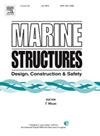在 OpenFAST 中实现地震土-结构相互作用,并应用于海上风力涡轮机的夹套结构
IF 5.1
2区 工程技术
Q1 ENGINEERING, CIVIL
引用次数: 0
摘要
海上风力涡轮机(OWT)设计的挑战之一是使用专门的水-气-液-动力分析软件进行分析,而这些软件通常无法严格执行地震土壤-结构相互作用(SSI)分析。本研究提出了一种方法,用于扩展这些工具,将地震 SSI 分析纳入这些工具,并具体应用于开源 OWT 分析工具 OpenFAST。所开发的方法适用于桩基护套结构上的 10 兆瓦海上风力涡轮机。SSI 采用多步骤子结构方法实现。该方法基于 SSI 的刚度和运动相互作用。夹套底座连接到桩基弹簧上,并受到地震时根据桩头运动计算出的力的激励。弹簧刚度和桩头运动可通过成熟的方法确定。在本报告中,我们使用有限元程序 Abaqus 对其进行了计算。然后使用夹套和塔架的互补集成 Abaqus 模型来验证 OpenFAST 中多步骤方法的实施情况。验证中使用了欧洲研究项目 INNWIND 中建立的 IEA 10 MW 参考 OWT。利用所开发的模型,本研究随后尝试研究 OWT 结构的一些地震响应特征。模拟结果表明,塔顶位移主要由转子-机舱组件生产过程中的风力引起,而塔顶加速度和底座倾覆力矩则主要由地震引起的载荷引起。本文章由计算机程序翻译,如有差异,请以英文原文为准。
Implementation of seismic soil-structure interaction in OpenFAST and application to an offshore wind turbine on jacket structure
One of the challenges in design of offshore wind turbines (OWTs) is that the analyses are performed using specialized software dedicated to hydro-aero-servo-elasto-dynamic analyses which often cannot rigorously perform seismic soil-structure interaction (SSI) analyses. This work presents a methodology to extend these tools to include seismic SSI analyses in these tools with a specific application in the open source OWT analysis tool OpenFAST. The developed method is applied to 10 MW offshore wind turbine on a jacket structure founded on piles. The SSI is implemented using a multi-step sub-structuring method. The method is based on the SSI stiffness and kinematic interaction. The jacket base is attached to pile foundation springs, and excited by forces calculated from the pile-head motions during the earthquake. The spring stiffness and pile-head motions can be determined using well-established methods. In this, they are obtained using the finite element program Abaqus. A complementary integrated Abaqus model of the jacket and tower is then used to verify the implementation of the multi-step method in OpenFAST. The IEA 10 MW reference OWT established in the European research project INNWIND is used in the verification. Using the developed model, the study then attempts to investigate some of the characteristic earthquake responses of the OWT structure. Simulations show how the top of tower displacements are dominated by the wind-induced forces during production form the rotor-nacelle-assembly, while the tower top accelerations and base overturning moments are dominated by the earthquake-induced loads.
求助全文
通过发布文献求助,成功后即可免费获取论文全文。
去求助
来源期刊

Marine Structures
工程技术-工程:海洋
CiteScore
8.70
自引率
7.70%
发文量
157
审稿时长
6.4 months
期刊介绍:
This journal aims to provide a medium for presentation and discussion of the latest developments in research, design, fabrication and in-service experience relating to marine structures, i.e., all structures of steel, concrete, light alloy or composite construction having an interface with the sea, including ships, fixed and mobile offshore platforms, submarine and submersibles, pipelines, subsea systems for shallow and deep ocean operations and coastal structures such as piers.
 求助内容:
求助内容: 应助结果提醒方式:
应助结果提醒方式:


